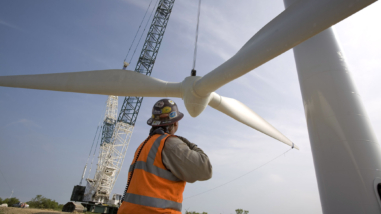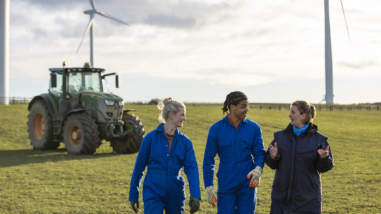Marilyn Waite is a program officer with the foundation’s Environment Program, which works to safeguard human health and well-being and protect populations from harmful climate change by advancing climate and clean energy solutions. Marilyn is developing a new and growing area of grantmaking around climate and clean energy finance. She explains what that means and how philanthropy fits in.
What brought you to working on climate change and clean energy?

I’ve long been attracted to solving pressing global challenges. It’s why I studied engineering, it’s why I chose to go to Madagascar to work on water resources as my first job, and it’s the common thread that weaves throughout my career. While living in the south of Madagascar, I went for a few months without reliable electricity. I witnessed the impact that a lack of electricity had on local businesses. The cyber café shut down, the refrigeration company shut down. It had ripple effects throughout the economy, employment included.
It’s hard to think about solving the pressing challenges of today without thinking about climate change, something that affects everyone on Earth and permeates our economy. Some of our most important economic hubs are also coastal cities, so whether it’s New York City in the U.S. or Shanghai in China, these locations are at risk of sea level rise because of climate change. Climate change impacts such as extreme drought, coastal flooding, and more intense and more frequent extreme weather events such as hurricanes, are being linked to changes in our macro-climate. These are all putting our real physical assets, and therefore our livelihoods, and everything that surrounds them, at risk. Worse, climate change is risking millions of human lives, particular in these coastal cities.
While working in nuclear and renewable energy in a number of capacities, I learned that a lot of our trouble has not been on the technology side but on the capital and investment side. I’m motivated by the work to help shape, mobilize and deploy the capital we need to solve climate change and therefore solve this pressing challenge for humanity.
What does ‘climate finance’ mean? What are the obstacles we are trying to address?
There are various levers you can pull on to drive change in society: policy, technology, and financial levers, to name a few. The financial lever has been underutilized in driving change, yet it underpins how everything works in our economy–it’s how money and resources flow. Climate finance is about mobilizing enough capital – public and private capital – to solve climate change and support all life on this planet.
Investors, at this point, need a three-pronged approach to using the power of investment to address the adverse effects of climate change:
- Finance the construction and operation of climate change mitigating projects, such as renewable energy and zero-carbon-emissions transportation, as just two examples.
- Reduce and halt their financing of activities that directly cause climate change.
- Enable changes in the financial systems so that true costs and benefits related to climate change are factored in and given real market values.
We are working in a broken system right now of future bets based on the wrong assumptions. The environmental externalities of emitting greenhouse gases – the increasing economic costs and social disruption of climate change paid through disasters, disaster relief, water shortages, flooding, disease, other costly tolls – are becoming too expensive to continue ignoring in our financial and economic calculations. Collecting the data, making sure that data is credible and reliable, and getting that information out there is a critical step for changing financial systems. When investors have the information about real risk, they can make wiser investment decisions. What gets measured gets managed.
What can philanthropy do in all of this?
The philanthropic community has a responsibility to address market failures, particularly where the result leads to adverse environmental, health and economic outcomes, and climate change is a textbook example of a market failure: an externality has not been priced into a market system. We might not have climate change if environmental pollution was adequately priced into everything. Philanthropy needs to do what it can to solve that.
Philanthropy can provide more patient capital. Philanthropic organizations can help create the conditions for sustainable investments by supporting work to develop renewable energy, sustainable transportation, and other socially beneficial climate interventions, and by supporting intermediary groups who can match investable projects to various asset classes, a critical step in getting these projects off the ground.
Philanthropy can also begin to support more bottom-up solutions. This is why I am launching an open call for proposals related to the retail banking sector – to hear from those who are not already in our circles, who are already doing this work, who plan on doing this work, or who are best positioned to do this work – on roles philanthropy could play to support climate change solutions in retail banking.
Philanthropy’s patient capital can demonstrate to other investors that perceived risk is not real risk. Think of it as a subsidy or catalyst that provides a proof of concept for other investors in areas with significant social and environmental impact return potential, while at the same time, illustrating how attractive financing the green economy can be. As an example, a group of philanthropists and foundations, the Hewlett Foundation included, formed a task force at President Macron’s One Planet Summit in Paris late last year, and they are currently working towards the creation of funds to accelerate the deployment of climate change mitigation solutions at scale.
Increasingly, governments and civil society are aligning the green economy and climate change goals with economic development and job creation, particularly in underserved communities. More people and organizations are focusing on equitable economic transitions. We need more granular analysis and planning for that transition. Philanthropy can support that type of work.
What excites you?
I’m excited about the nexus between financial technology and climate change. I’m excited about public green banks serving as models for business innovation. I’m also excited about green bonds, and climate bonds in particular; their current oversubscription indicates a need to provide more technical assistance and working capital so that companies and issuers can meet the investor demand. I’m interested in the valley of death problem in early stage capital for climate tech—we still need a number of new business models and technological solutions to scale.
I’m also excited about how to use the retail banking space as a lever for change. We need $1 trillion annually in investments to solve climate change, aligning with the Paris Agreement. There are $12 trillion in deposits in the U.S. alone, and there are still 23 million U.S. residents who are unbanked or underbanked. There is great opportunity in helping people and businesses make responsible decisions about their money.
Do you have a personal philosophy in this work, as you build this portfolio?
My priority has been to listen to a lot of different stakeholders, to take in every request to speak to me, to seize every opportunity to hear from people who are outside of our current networks. It’s a new approach for us, so we need new and different partnerships and perspectives. It’s also a new field that is growing and developing, and that’s due to innovative thinking and creative approaches, which emanate from diverse thinkers and new players in the field.
I approach the work this way: you don’t know what you don’t know, and the answer you get depends on the question you ask. The way we’ve been asking the question thus far has lent itself toward certain answers. I want to ask the question in new and different ways, and I want to ask new and different people the questions. And to solve climate change, we absolutely need to. There are gaps in philanthropic funding in this field and thus tremendous opportunity.
Remember, our goal isn’t just to mobilize the capital, it’s to solve a problem that impacts every corner of our world. This problem of climate change isn’t solved yet, and we don’t know everything, we don’t know everyone. Our open call for proposals is the first milestone to move us closer to our goal.




